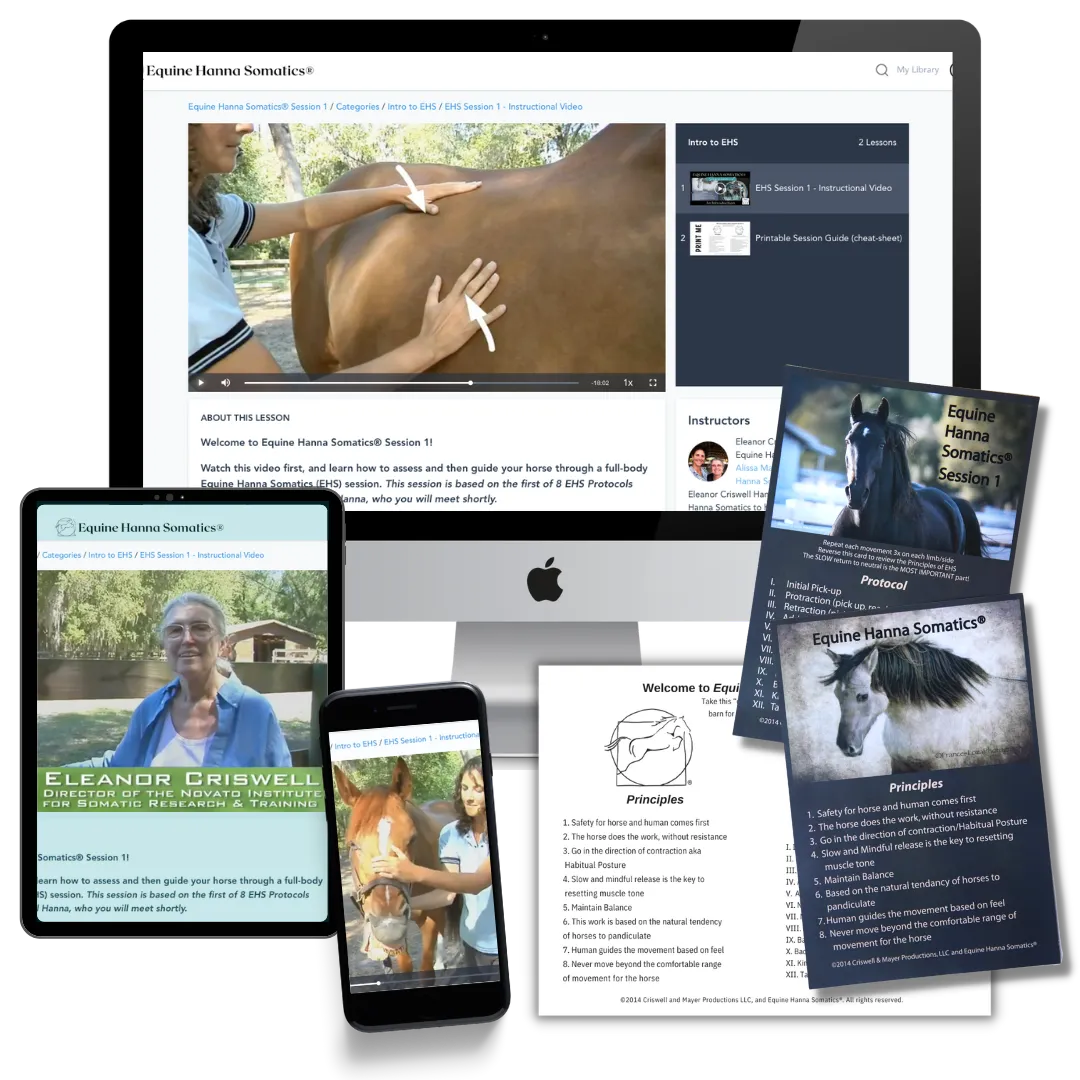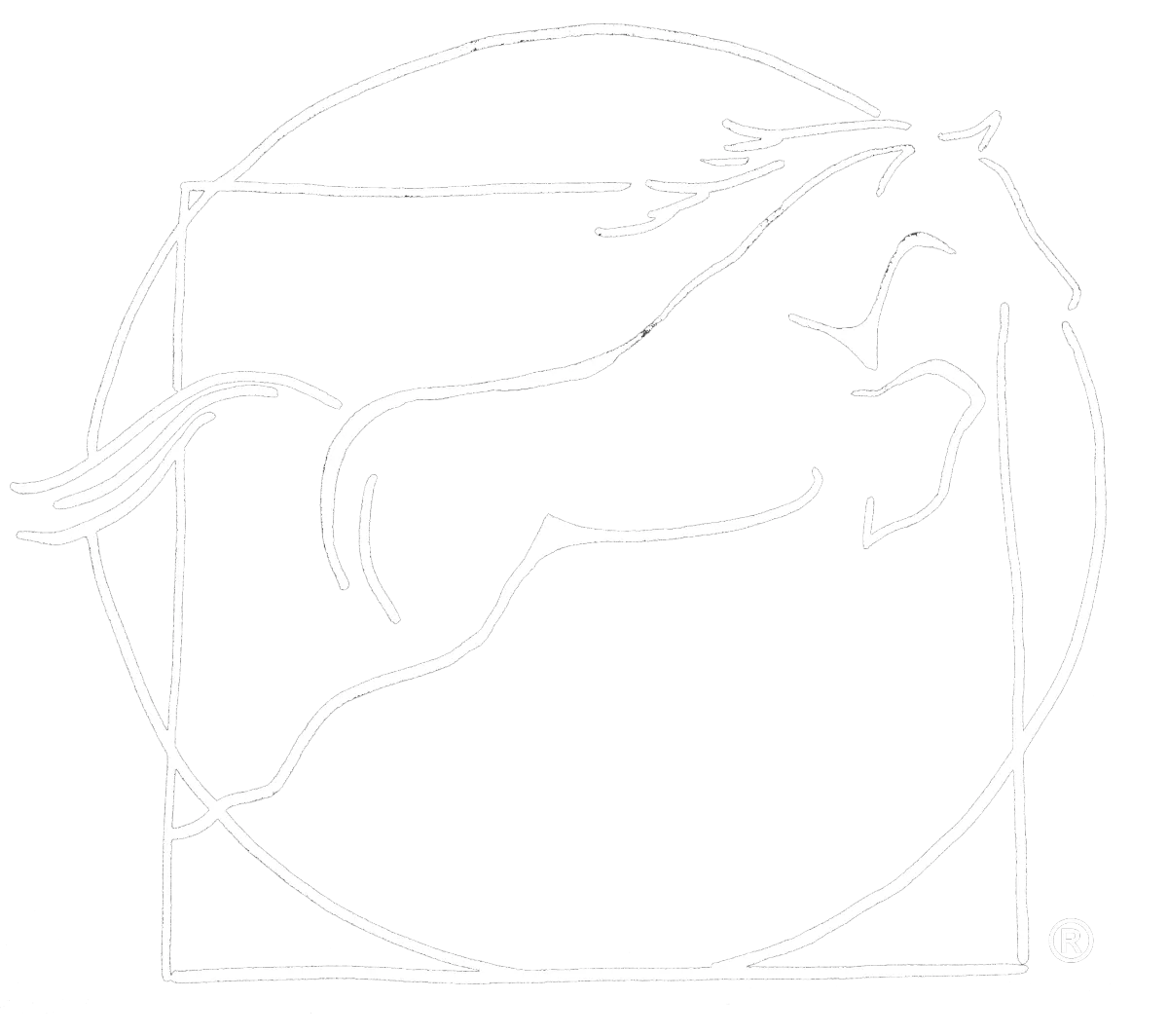Roach Back Posture & the Iliopsoas Muscles in Horses
Horses do not choose their posture, posture is not caused by muscle dysfunction but by muscle activity, and a roached back is actually part of a full-body postural pattern called the Red Light Posture that develops as an adaptive central nervous system response to stress.
What causes a roached back (aka Kyphosis) in horses?
Kyphosis is a dorsal deviation of the thoracolumbar spine (Domańska-Kruppa et al., 2024). Another way to describe kyphosis or a ‘roach back’ is a visible upward arch of the horses back that starts somewhere in the middle and is most apparent over the lumbar or loin area.
Congenital Kyphosis is a fairly rare conformation defect where the dorsal spinus processes of the lumbar vertebrae are abnormally tall, producing an arch from the horses mid-back to the LS joint, which may or may not include more curve than normal in the vertebral chain itself. (Bennett, 2022)

Young horse with a roached back (photographer unknown).
Acquired Kyphosis is a roached back that has not been present since birth, therefore is not conformational but is caused by something in the horses life - an injury or trauma that has changed the way the horses spine is positioned OR how the lumbar spine is organized as posture by muscle activity. There are other types of acquired posture that tend to present in one of the three characteristic postural patterns first identified by Thomas Hanna in humans, and later identified in horses and dogs (and many other animals) by Eleanor Criswell when she developed Equine Hanna Somatics® and Canine Hanna Somatics®.
These three clearly recognizable postural patterns are known as the Red Light Posture (characterized by spinal flexion, often a roached back, tucked pelvis and other factors), the Green Light Posture (characterized by spinal extension, ewe-neck, a hollow back and other factors) and the Trauma/Asymmetry Posture (characterized by asymmetry and/or extremely limited range-of-motion due to co-contractions), but we'll talk more about those in another post. ;)
So when we see a horse presenting with a roached back and camped under posture of the hind limbs, what we are seeing is either a rare conformation defect, the result of a major traumatic injury, or an expression of active iliopsoas muscles that are frequently part of a body-wide habituated stress response - the Red Light Reflex.
The Equine Iliopsoas Complex Muscles
Contractions of the Iliopsoas Complex of muscles (the psoas major, psoas minor and the iliacus muscles) and/or other muscles located below the vertebral chain put the horses torso into a flexed position (Bennett, 2008).

Illustration from Pasquini's Atlas of Equine Anatomy, p.105
The specific functions of the iliopsoas muscles, (in a horse, dog or person), are to tuck the pelvis, coil the loins and draw the hindlimb (the femur) forward into protraction. Flexing the torso is an essential part of equine movement. Lifting the back into flexion is also the precursor to picking up any limb, or shifting the weight from the front limbs to the hind limbs as is required for ‘collection’ or ‘lightness.’
A healthy horse will be able to flex and extend their torso as needed, and go back to a neutral baseline in between. A neutral resting muscle tone is required to have maximum Range-of-Motion, strength, suppleness and overall health and well-being.
Unfortunately, due to the unnaturally high level of stress and physical demands on domestic horses, like humans, many horses develop habitual contractions of various muscles that raise their resting muscle tone above the ‘normal neutral’ baseline. This elevated resting muscle tone increases the forces produced by the affected muscles even while they are at rest, which results in postural deviations that do not have any obvious purpose or cause - unless you know what to look for.
Typically, a horse with a roached back caused by habitually contracted iliopsoas muscles will still be able to function, but will have limited range-of-motion. Many are comfortable enough to be ridden and some are even performing at the top levels of their sport. They are more or less able to extend their back as needed, and at times (when excited, when assisted or cued by a skilled rider, or when exerting effort) may be able to hold a more ‘correct back posture’ for short periods. But they will keep returning to their default roached-back posture over and over.

However, the chronically contracted muscles are not able to perform up to their full length or strength, and will actively resist allowing movement in the opposite direction, which creates ‘stiffness’ as the joints in the area are overly stabilized by the tight muscles. This increases the muscular effort required to move, and also increases the rate of wear and tear on the involved soft tissues, joints and bones until the horse can change their resting muscle tone back to neutral. This is exactly what we help horses do with Equine Hanna Somatics® exercises.
In contrast, a horse who has a conformationally roached back, will be truly locked into their posture and unable to move differently or change their posture when asked or pressured. These horses can also benefit from EHS, but we would not expect them to change their roach-back posture at all, although other postural deviations can still be improved.
A horse who is in the acute stage of an injury to their back or iliopsoas muscles may adopt a roach-back stance to ease or avoid pain - called antalgic posture. They will typically avoid moving out of their roach-back shape, even for a moment, and will show immediate signs of discomfort or anger if asked to move or stand differently. Until the acute phase of the injury has passed, and a vet has cleared the horse to return to light work (like hand walking) they are not a candidate to participate in EHS.
What causes chronic muscle contractions?
Have you heard the phrase “Practice makes permanent?” Repeated contractions of a muscle lead to an adaptive response of the central nervous system, in which a horse (or person or other animal) ‘learns’ to keep doing on autopilot anything that is practiced enough. It doesn’t matter whether you are practicing a movement on purpose, or whether you are responding to an environmental challenge (like living on a slope) or if you are simply being startled over and over (which causes particular muscles to involuntarily contract each time). Repetition leads to habituation.
Once a muscle contraction becomes habituated, the nervous system will continue to maintain the ‘learned’ tension below the level of conscious awareness, even after the practice that caused it ends.
Equine Habitual Posture
A roached back is part of a larger full-body postural pattern called the Red Light Reflex, which is one of the four universal postures we recognize and resolve with Equine Hanna Somatics Education.
Repeated exposure to stressors without the ability to flee causes the horses ventral flexor muscles, including the iliopsoas, to contract frequently - producing the posture commonly associated with an introverted horseonality, a horse who is ‘shut-down’ or otherwise exhibiting the symptoms of learned helplessness. When a horse has a roach back, it frequently also has other postural deviations.
Roach back in Racehorses or Off-Track Thoroughbreds

Repetitive motions that involve strongly contracting and stretching the psoas (like galloping at speed or jumping) frequently contribute to the development of habitual tension in the iliopsoas muscles, which is why a roached lumbar area is so often seen in racehorses and OTTBs.
Roach back posture as a compensation for hoof pain
General forelimb pain avoidance, (like leaning backward to relieve sore hooves from thin soles or laminitis, for example) also creates repetitive contractions of the iliopsoas muscles. Incidentally, being ‘stuck’ in a Red Light Posture may also cause or serve to maintain a negative palmar angle (NPA) in the hind hooves.
Poor condition can be mislabeled as an equine roached back
When horses are severely underweight, their spine, which is normally covered by a thick layer of muscle, becomes visible, and the natural upward arch of the lumbar vertebral processes becomes visible, which can be mistaken for a roached back.

Alissa Mayer demonstrates with an articulated equine skeleton. Photo by Catherine Davey ©2018
Can ‘Worm Aneurisms’ cause a Roach Back in horses?
It has been suggested that irritation from encysted large strongly larva in the cranial mesentery artery (aka 'worm aneurisms') can cause horses to adopt a roach-back posture, although at the time of this post I am not aware of any literature on this topic.
It is of course reasonable that pain or discomfort from parasites, digestive issues, soft tissue injuries, inflammation or irritation can be the precursor to a horse adopting a roach-backed posture, but the roaching itself is caused by a contraction of the iliopsoas muscles.
In summary, unless the horse was born that way, has suffered a major spinal injury or currently has injured or inflamed iliopsoas muscles, a horse presenting a roach back is actively experiencing muscle contractions that put the body into that shape.
In cases where an acute injury has already been ruled out by a veterinarian, it can be reasonably assumed that something else is causing the muscles to continue contracting to maintain the postural deviation… Our job, as horse advocates, equine professionals, owners, bodyworkers or somatic educators, is to use our inquiring and logical minds to determine how and why these muscles are chronically contracting, so we can help our horses get back to feeling amazing again!
RESOURCES
Bennett, D. (2008) The Ring of Muscles Revisited. Equine Studies Institute. https://www.equinestudies.org/_files/ugd/7f2126_2556d8249bce44a39404cc990de8574c.pdf
Bennett, D. (2022) Horse Conformation Volume II: The Axial Body, Head, Neck, Back & Teeth. Equine Studies Institute Press
Bordoni B, Varacallo MA. Anatomy, Bony Pelvis and Lower Limb, Iliopsoas Muscle. [Updated 2023 Apr 24]. In: StatPearls [Internet]. Treasure Island (FL): StatPearls Publishing; 2025 Jan-. Available from: https://www.ncbi.nlm.nih.gov/books/NBK531508/
Criswell, E. & Mayer, A. (2006-2025) Equine Hanna Somatics® Professional Training Program Manual
Domańska-Kruppa, N., Wierzbicka, M., & Stefanik, E. (2024). Advances in the Clinical Diagnostics to Equine Back Pain: A Review of Imaging and Functional Modalities. Animals : an open access journal from MDPI, 14(5), 698. https://doi.org/10.3390/ani14050698




